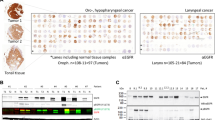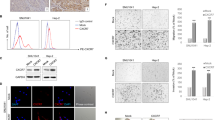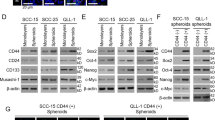Abstract
Epidermal growth factor receptor (EGFR) is frequently overexpressed in head and neck squamous cell carcinoma (HNSCC) where aberrant signaling downstream of this receptor contributes to tumor growth. EGFR variant III (EGFRvIII) is the most commonly altered form of EGFR and contains a truncated ligand-binding domain. We previously reported that EGFRvIII is expressed in up to 40% of HNSCC tumors where it is associated with increased proliferation, tumor growth and chemoresistance to antitumor drugs including the EGFR-targeting monoclonal antibody cetuximab. Cetuximab was FDA-approved in 2006 for HNSCC but has not been shown to prevent invasion or metastasis. This study was undertaken to evaluate the mechanisms of EGFRvIII-mediated cell motility and invasion in HNSCC. We found that EGFRvIII induced HNSCC cell migration and invasion in conjunction with increased signal transducer and activator of transcription 3 (STAT3) activation, which was not abrogated by cetuximab treatment. Further investigation showed that EGF-induced expression of the STAT3 target gene HIF1-α, was abolished by cetuximab in HNSCC cells expressing wild-type EGFR under hypoxic conditions, but not in EGFRvIII-expressing HNSCC cells. These results suggest that EGFRvIII mediates HNSCC cell migration and invasion by increased STAT3 activation and induction of HIF1-α, which contribute to cetuximab resistance in EGFRvIII-expressing HNSCC tumors.
This is a preview of subscription content, access via your institution
Access options
Subscribe to this journal
Receive 50 print issues and online access
$259.00 per year
only $5.18 per issue
Buy this article
- Purchase on Springer Link
- Instant access to full article PDF
Prices may be subject to local taxes which are calculated during checkout






Similar content being viewed by others
References
Andersen P, Pedersen MW, Woetmann A, Villingshoj M, Stockhausen MT, Odum N et al. (2008). EGFR induces expression of IRF-1 via STAT1 and STAT3 activation leading to growth arrest of human cancer cells. Int J Cancer 122: 342–349.
Antonyak MA, Moscatello DK, Wong AJ . (1998). Constitutive activation of c-Jun N-terminal kinase by a mutant epidermal growth factor receptor. J Biol Chem 273: 2817–2822.
Besser D, Bromberg JF, Darnell Jr JE, Hanafusa H . (1999). A single amino acid substitution in the v-Eyk intracellular domain results in activation of Stat3 and enhances cellular transformation. Mol Cell Biol 19: 1401–1409.
Bigner SH, Humphrey PA, Wong AJ, Vogelstein B, Mark J, Friedman HS et al. (1990). Characterization of the epidermal growth factor receptor in human glioma cell lines and xenografts. Cancer Res 50: 8017–8022.
Bonner JA, Harari PM, Giralt J, Azarnia N, Shin DM, Cohen RB et al. (2006). Radiotherapy plus cetuximab for squamous-cell carcinoma of the head and neck. N Engl J Med 354: 567–578.
Bowman T, Garcia R, Turkson J, Jove R . (2000). STATs in oncogenesis. Oncogene 19: 2474–2488.
Cai XM, Tao BB, Wang LY, Liang YL, Jin JW, Yang Y et al. (2005). Protein phosphatase activity of PTEN inhibited the invasion of glioma cells with epidermal growth factor receptor mutation type III expression. Int J Cancer 117: 905–912.
Dechow TN, Pedranzini L, Leitch A, Leslie K, Gerald WL, Linkov I et al. (2004). Requirement of matrix metalloproteinase-9 for the transformation of human mammary epithelial cells by Stat3-C. Proc Natl Acad Sci USA 101: 10602–10607.
Diedrich U, Lucius J, Baron E, Behnke J, Pabst B, Zoll B . (1995). Distribution of epidermal growth factor receptor gene amplification in brain tumours and correlation to prognosis. J Neurol 242: 683–688.
Garcia de Palazzo IE, Adams GP, Sundareshan P, Wong AJ, Testa JR, Bigner DD et al. (1993). Expression of mutated epidermal growth factor receptor by non-small cell lung carcinomas. Cancer Res 53: 3217–3220.
Germain D, Frank DA . (2007). Targeting the cytoplasmic and nuclear functions of signal transducers and activators of transcription 3 for cancer therapy. Clin Cancer Res 13: 5665–5669.
Grandis JR, Drenning SD, Chakraborty A, Zhou MY, Zeng Q, Pitt AS et al. (1998). Requirement of Stat3 but not Stat1 activation for epidermal growth factor receptor-mediated cell growth in vitro. J Clin Invest 102: 1385–1392.
Grandis JR, Tweardy DJ . (1993). TGF-alpha and EGFR in head and neck cancer. J Cell Biochem Suppl 17F: 188–191.
Huang M, Dorsey JF, Epling-Burnette PK, Nimmanapalli R, Landowski TH, Mora LB et al. (2002). Inhibition of Bcr-Abl kinase activity by PD180970 blocks constitutive activation of Stat5 and growth of CML cells. Oncogene 21: 8804–8816.
Ji H, Zhao X, Yuza Y, Shimamura T, Li D, Protopopov A et al. (2006). Epidermal growth factor receptor variant III mutations in lung tumorigenesis and sensitivity to tyrosine kinase inhibitors. Proc Natl Acad Sci USA 103: 7817–7822.
Kijima T, Niwa H, Steinman RA, Drenning SD, Gooding WE, Wentzel AL et al. (2002). Stat3-mediated EGFR-independent growth in SCCHN. Cell Growth Differ 13: 355–362.
Kira M, Sano S, Takagi S, Yoshikawa K, Takeda J, Itami S . (2002). STAT3 deficiency in keratinocytes leads to compromised cell migration through hyperphosphorylation of p130(cas). J Biol Chem 277: 12931–12936.
Lal A, Glazer CA, Martinson HM, Friedman HS, Archer GE, Sampson JH et al. (2002). Mutant epidermal growth factor receptor up-regulates molecular effectors of tumor invasion. Cancer Res 62: 3335–3339.
Leeman RJ, Lui VW, Grandis JR . (2006). STAT3 as a therapeutic target in head and neck cancer. Expert Opin Biol Ther 6: 231–241.
Leong PL, Andrews GA, Johnson DE, Dyer KF, Xi S, Mai JC et al. (2003). Targeted inhibition of Stat3 with a decoy oligonucleotide abrogates head and neck cancer cell growth. Proc Natl Acad Sci USA 100: 4138–4143.
Li B, Yuan M, Kim IA, Chang CM, Bernhard EJ, Shu HK . (2004). Mutant epidermal growth factor receptor displays increased signaling through the phosphatidylinositol-3 kinase/AKT pathway and promotes radioresistance in cells of astrocytic origin. Oncogene 23: 4594–4602.
Li D, Ji H, Zaghlul S, McNamara K, Liang MC, Shimamura T et al. (2007). Therapeutic anti-EGFR antibody 806 generates responses in murine de novo EGFR mutant-dependent lung carcinomas. J Clin Invest 117: 346–352.
Masuda M, Suzui M, Yasumatu R, Nakashima T, Kuratomi Y, Azuma K et al. (2002). Constitutive activation of signal transducers and activators of transcription 3 correlates with cyclin D1 overexpression and may provide a novel prognostic marker in head and neck squamous cell carcinoma. Cancer Res 62: 3351–3355.
Mizoguchi M, Betensky RA, Batchelor TT, Bernay DC, Louis DN, Nutt CL . (2006). Activation of STAT3, MAPK, and AKT in malignant astrocytic gliomas: correlation with EGFR status, tumor grade, and survival. J Neuropathol Exp Neurol 65: 1181–1188.
Moscatello DK, Holgado-Madruga M, Emlet DR, Montgomery RB, Wong AJ . (1998). Constitutive activation of phosphatidylinositol 3-kinase by a naturally occurring mutant epidermal growth factor receptor. J Biol Chem 273: 200–206.
Moscatello DK, Holgado-Madruga M, Godwin AK, Ramirez G, Gunn G, Zoltick PW et al. (1995). Frequent expression of a mutant epidermal growth factor receptor in multiple human tumors. Cancer Res 55: 5536–5539.
Nagane M, Levitzki A, Gazit A, Cavenee WK, Huang HJ . (1998). Drug resistance of human glioblastoma cells conferred by a tumor-specific mutant epidermal growth factor receptor through modulation of Bcl-XL and caspase-3-like proteases. Proc Natl Acad Sci USA 95: 5724–5729.
Narita Y, Nagane M, Mishima K, Huang HJ, Furnari FB, Cavenee WK . (2002). Mutant epidermal growth factor receptor signaling down-regulates p27 through activation of the phosphatidylinositol 3-kinase/Akt pathway in glioblastomas. Cancer Res 62: 6764–6769.
Ng DC, Lin BH, Lim CP, Huang G, Zhang T, Poli V et al. (2006). Stat3 regulates microtubules by antagonizing the depolymerization activity of stathmin. J Cell Biol 172: 245–257.
Niu G, Briggs J, Deng J, Ma Y, Lee H, Kortylewski M et al. (2008). Signal transducer and activator of transcription 3 is required for hypoxia-inducible factor-1alpha RNA expression in both tumor cells and tumor-associated myeloid cells. Mol Cancer Res 6: 1099–1105.
Olapade-Olaopa EO, Moscatello DK, MacKay EH, Horsburgh T, Sandhu DP, Terry TR et al. (2000). Evidence for the differential expression of a variant EGF receptor protein in human prostate cancer. Br J Cancer 82: 186–194.
Oritani K, Tomiyama Y, Kincade PW, Aoyama K, Yokota T, Matsumura I et al. (1999). Both Stat3-activation and Stat3-independent BCL2 downregulation are important for interleukin-6-induced apoptosis of 1A9-M cells. Blood 93: 1346–1354.
Pedersen MW, Meltorn M, Damstrup L, Poulsen HS . (2001). The type III epidermal growth factor receptor mutation. Biological significance and potential target for anti-cancer therapy. Ann Oncol 12: 745–760.
Pedersen MW, Tkach V, Pedersen N, Berezin V, Poulsen HS . (2004). Expression of a naturally occurring constitutively active variant of the epidermal growth factor receptor in mouse fibroblasts increases motility. Int J Cancer 108: 643–653.
Qiu Z, Huang C, Sun J, Qiu W, Zhang J, Li H et al. (2007). RNA interference-mediated signal transducers and activators of transcription 3 gene silencing inhibits invasion and metastasis of human pancreatic cancer cells. Cancer Sci 98: 1099–1106.
Sano S, Chan KS, Carbajal S, Clifford J, Peavey M, Kiguchi K et al. (2005). Stat3 links activated keratinocytes and immunocytes required for development of psoriasis in a novel transgenic mouse model. Nat Med 11: 43–49.
Sen M, Tosca PJ, Zwayer C, Ryan MJ, Johnson JD, Knostman KA et al. (2008). Lack of toxicity of a STAT3 decoy oligonucleotide. Cancer Chemother Pharmacol 63: 983–995.
Silver DL, Naora H, Liu J, Cheng W, Montell DJ . (2004). Activated signal transducer and activator of transcription (STAT) 3: localization in focal adhesions and function in ovarian cancer cell motility. Cancer Res 64: 3550–3558.
Sinibaldi D, Wharton W, Turkson J, Bowman T, Pledger WJ, Jove R . (2000). Induction of p21WAF1/CIP1 and cyclin D1 expression by the Src oncoprotein in mouse fibroblasts: role of activated STAT3 signaling. Oncogene 19: 5419–5427.
Sok JC, Coppelli FM, Thomas SM, Lango MN, Xi S, Hunt JL et al. (2006). Mutant epidermal growth factor receptor (EGFRvIII) contributes to head and neck cancer growth and resistance to EGFR targeting. Clin Cancer Res 12: 5064–5073.
Sriuranpong V, Park JI, Amornphimoltham P, Patel V, Nelkin BD, Gutkind JS . (2003). Epidermal growth factor receptor-independent constitutive activation of STAT3 in head and neck squamous cell carcinoma is mediated by the autocrine/paracrine stimulation of the interleukin 6/gp130 cytokine system. Cancer Res 63: 2948–2956.
Sugawa N, Ekstrand AJ, James CD, Collins VP . (1990). Identical splicing of aberrant epidermal growth factor receptor transcripts from amplified rearranged genes in human glioblastomas. Proc Natl Acad Sci USA 87: 8602–8606.
Tang C, Shou M, Mei Q, Rushmore TH, Rodrigues AD . (2000). Major role of human liver microsomal cytochrome P450 2C9 (CYP2C9) in the oxidative metabolism of celecoxib, a novel cyclooxygenase-II inhibitor. J Pharmacol Exp Ther 293: 453–459.
Thomas SM, Coppelli FM, Wells A, Gooding WE, Song J, Kassis J et al. (2003). Epidermal growth factor receptor-stimulated activation of phospholipase Cgamma-1 promotes invasion of head and neck squamous cell carcinoma. Cancer Res 63: 5629–5635.
Vermorken JB, Trigo J, Hitt R, Koralewski P, Diaz-Rubio E, Rolland F et al. (2007). Open-label, uncontrolled, multicenter phase II study to evaluate the efficacy and toxicity of cetuximab as a single agent in patients with recurrent and/or metastatic squamous cell carcinoma of the head and neck who failed to respond to platinum-based therapy. J Clin Oncol 25: 2171–2177.
Weppler SA, Li Y, Dubois L, Lieuwes N, Jutten B, Lambin P et al. (2007). Expression of EGFR variant vIII promotes both radiation resistance and hypoxia tolerance. Radiother Oncol 83: 333–339.
Xi S, Gooding WE, Grandis JR . (2005). in vivo antitumor efficacy of STAT3 blockade using a transcription factor decoy approach: implications for cancer therapy. Oncogene 24: 970–979.
Xi S, Zhang Q, Dyer KF, Lerner EC, Smithgall TE, Gooding WE et al. (2003). Src kinases mediate STAT growth pathways in squamous cell carcinoma of the head and neck. J Biol Chem 278: 31574–31583.
Zhang Q, Thomas SM, Xi S, Smithgall TE, Siegfried JM, Kamens J et al. (2004). SRC family kinases mediate epidermal growth factor receptor ligand cleavage, proliferation, and invasion of head and neck cancer cells. Cancer Res 64: 6166–6173.
Acknowledgements
This work was supported by Grants RO1 CA77308, RO1 CA101840 and P50 CA097190, and an American Cancer Society Clinical Research professorship CRP-08-229-01 (to JRG) and the NIH core Grant EY08098.
Author information
Authors and Affiliations
Corresponding author
Ethics declarations
Competing interests
The authors declare no conflict of interest.
Rights and permissions
About this article
Cite this article
Wheeler, S., Suzuki, S., Thomas, S. et al. Epidermal growth factor receptor variant III mediates head and neck cancer cell invasion via STAT3 activation. Oncogene 29, 5135–5145 (2010). https://doi.org/10.1038/onc.2009.279
Received:
Revised:
Accepted:
Published:
Issue Date:
DOI: https://doi.org/10.1038/onc.2009.279
Keywords
This article is cited by
-
Chemoresistant fibroblasts dictate neoadjuvant chemotherapeutic response of head and neck cancer via TGFα-EGFR paracrine signaling
npj Precision Oncology (2023)
-
STAT3 mediates RCP-induced cancer cell invasion through the NF-κB/Slug/MT1-MMP signaling cascade
Archives of Pharmacal Research (2022)
-
DMP-1 promoter-associated antisense strand non-coding RNA, panRNA-DMP-1, physically associates with EGFR to repress EGF-induced squamous cell carcinoma migration
Molecular and Cellular Biochemistry (2021)
-
TGFβ3-mediated induction of Periostin facilitates head and neck cancer growth and is associated with metastasis
Scientific Reports (2016)
-
HDAC7 inhibition resets STAT3 tumorigenic activity in human glioblastoma independently of EGFR and PTEN: new opportunities for selected targeted therapies
Oncogene (2016)



